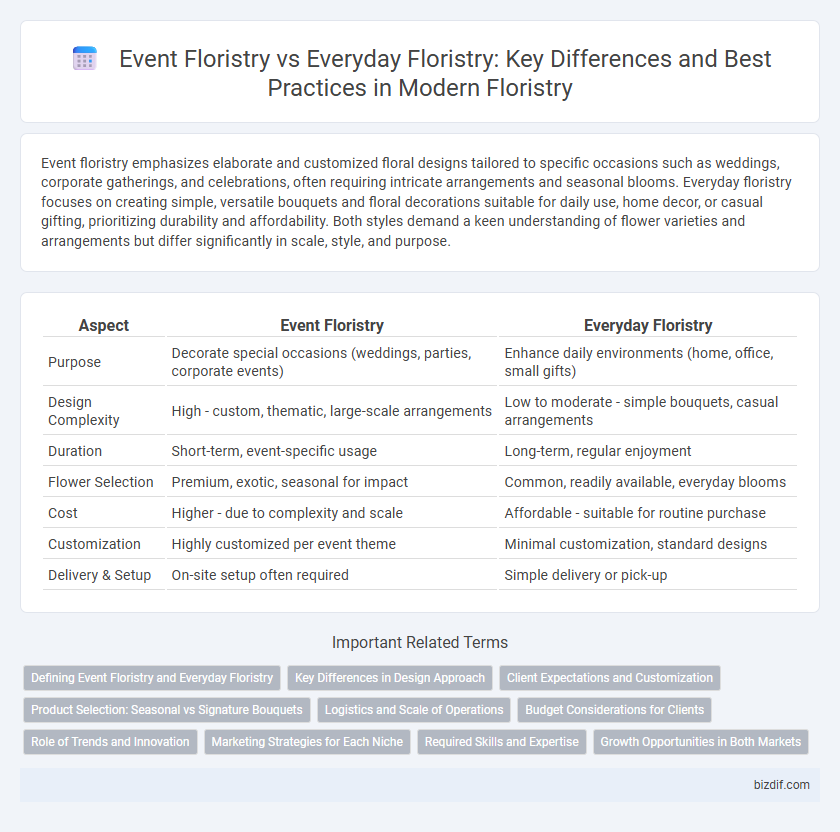Event floristry emphasizes elaborate and customized floral designs tailored to specific occasions such as weddings, corporate gatherings, and celebrations, often requiring intricate arrangements and seasonal blooms. Everyday floristry focuses on creating simple, versatile bouquets and floral decorations suitable for daily use, home decor, or casual gifting, prioritizing durability and affordability. Both styles demand a keen understanding of flower varieties and arrangements but differ significantly in scale, style, and purpose.
Table of Comparison
| Aspect | Event Floristry | Everyday Floristry |
|---|---|---|
| Purpose | Decorate special occasions (weddings, parties, corporate events) | Enhance daily environments (home, office, small gifts) |
| Design Complexity | High - custom, thematic, large-scale arrangements | Low to moderate - simple bouquets, casual arrangements |
| Duration | Short-term, event-specific usage | Long-term, regular enjoyment |
| Flower Selection | Premium, exotic, seasonal for impact | Common, readily available, everyday blooms |
| Cost | Higher - due to complexity and scale | Affordable - suitable for routine purchase |
| Customization | Highly customized per event theme | Minimal customization, standard designs |
| Delivery & Setup | On-site setup often required | Simple delivery or pick-up |
Defining Event Floristry and Everyday Floristry
Event floristry involves creating elaborate floral designs tailored for special occasions such as weddings, corporate events, and parties, emphasizing large-scale, thematic arrangements. Everyday floristry focuses on simpler, versatile bouquets and floral decorations intended for daily use, home decor, or casual gifting, prioritizing freshness and ease of maintenance. Both disciplines require knowledge of flower types, seasonal availability, and design principles but differ significantly in scale, complexity, and purpose.
Key Differences in Design Approach
Event floristry emphasizes dramatic, large-scale arrangements tailored to specific themes and venues, incorporating seasonal blooms and bold color palettes to create memorable visual impact. Everyday floristry prioritizes simplicity and versatility, using fresh, easily maintainable flowers in subtle hues suited for daily environments like homes or offices. The design approach in event floristry is highly customized and elaborate, while everyday floristry focuses on practicality and timeless elegance.
Client Expectations and Customization
Event floristry demands high customization to match specific themes, color schemes, and venue aesthetics, with clients expecting intricate designs and cohesive arrangements that enhance the overall experience. Everyday floristry prioritizes simplicity and versatility, offering ready-made or easily adaptable bouquets catering to routine gifting or personal enjoyment with quicker turnaround times. Clients in event floristry often require detailed consultations and unique floral artistry, while everyday floristry focuses on convenience and affordability.
Product Selection: Seasonal vs Signature Bouquets
Event floristry emphasizes seasonal product selection, incorporating flowers at peak bloom to enhance the event's theme and atmosphere. Everyday floristry prioritizes signature bouquets featuring consistent, year-round floral varieties that cater to regular customer preferences and ensure availability. Both approaches balance fresh, high-quality blooms but differ in the intentionality behind flower choice and presentation.
Logistics and Scale of Operations
Event floristry involves large-scale logistics, including coordination with venues, delivery scheduling, and on-site setup requiring specialized equipment and teams to handle bulk flower orders efficiently. Everyday floristry operates on a smaller scale, focusing on quick turnaround, local deliveries, and maintaining fresh inventory for regular customer demand. Efficient supply chain management and inventory control are crucial in both sectors but differ significantly in complexity and scale.
Budget Considerations for Clients
Event floristry typically demands a higher budget due to the scale, intricacy, and customization of floral arrangements required for weddings, corporate functions, or large celebrations. Everyday floristry, centered on simpler bouquets and seasonal blooms, offers more budget-friendly options suitable for regular home decor or small gifts. Clients should consider the complexity, flower varieties, and delivery logistics, as these factors significantly impact overall pricing in both event and everyday floral services.
Role of Trends and Innovation
Event floristry prioritizes cutting-edge trends and innovative designs to create memorable, statement-making arrangements tailored for specific occasions, often involving seasonal blooms, unique textures, and bold color palettes. Everyday floristry emphasizes timeless, versatile arrangements that blend classic styles with subtle innovation to suit daily use and enhance regular environments, focusing on longevity and ease of maintenance. The integration of technology, eco-friendly materials, and evolving floral techniques drives creativity and sustainability across both event and everyday floristry sectors.
Marketing Strategies for Each Niche
Event floristry marketing strategies emphasize creating bespoke floral designs that match specific themes and occasions, leveraging social media portfolios and collaborations with wedding planners and event coordinators to attract high-end clients. Everyday floristry marketing focuses on building customer loyalty through subscription services, seasonal promotions, and local community engagement such as farmers markets and boutique partnerships. Data-driven targeting using analytics can optimize ad spend by distinguishing between one-time event customers and repeat everyday floral buyers.
Required Skills and Expertise
Event floristry demands advanced skills in large-scale floral design, spatial arrangement, and client communication to create cohesive themes for weddings, corporate events, and ceremonies. Everyday floristry requires expertise in quick, versatile bouquet assembly, knowledge of flower care, and customer preferences for retail settings. Mastery in event floristry involves project management and teamwork, while everyday floristry emphasizes efficiency and personalized service.
Growth Opportunities in Both Markets
Event floristry commands significant growth opportunities due to high demand for weddings, corporate gatherings, and seasonal celebrations, driving premium pricing and creative floral design trends. Everyday floristry benefits from steady consumer interest in home decor, gifting, and sustainable flowers, with increasing adoption of subscription services boosting consistent revenue streams. Leveraging digital marketing and eco-friendly practices enhances market reach and customer retention in both event and everyday floristry sectors.
Event floristry vs Everyday floristry Infographic

 bizdif.com
bizdif.com